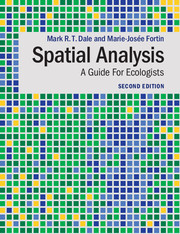Book contents
- Frontmatter
- Dedication
- Contents
- Preface
- 1 Spatial concepts and notions
- 2 Ecological and spatial processes
- 3 Points, lines and graphs
- 4 Spatial analysis of complete point location data
- 5 Contiguous units analysis
- 6 Spatial analysis of sample data
- 7 Spatial relationship and multiscale analysis
- 8 Spatial autocorrelation and inferential tests
- 9 Spatial partitioning: spatial clusters and boundary detection
- 10 Spatial diversity analysis
- 11 Spatio-temporal analysis
- 12 Closing comments and future directions
- References
- Index
11 - Spatio-temporal analysis
Published online by Cambridge University Press: 05 September 2014
- Frontmatter
- Dedication
- Contents
- Preface
- 1 Spatial concepts and notions
- 2 Ecological and spatial processes
- 3 Points, lines and graphs
- 4 Spatial analysis of complete point location data
- 5 Contiguous units analysis
- 6 Spatial analysis of sample data
- 7 Spatial relationship and multiscale analysis
- 8 Spatial autocorrelation and inferential tests
- 9 Spatial partitioning: spatial clusters and boundary detection
- 10 Spatial diversity analysis
- 11 Spatio-temporal analysis
- 12 Closing comments and future directions
- References
- Index
Summary
Introduction
This chapter expands the discussion of the analysis of spatial structure to include the temporal dimension of ecological processes resulting spatial patterns. The intimate relationship between spatial structure and temporal change in ecological systems was eloquently described by Watt (1947) in his famous discourse on pattern and process in plant communities. His theme was that a plant community could be viewed as a working mechanism with the dynamic behaviours of development, degradation, and regeneration. In many plant communities, the various phases of the dynamic process coexist, and may have an identifiable spatial relationship to each other (Figure 11.1). In communities and populations of animals, the relationship between spatial locations and dynamic processes can be even more obvious, as animals move through the spatial structure of their habitat to find resources or mates, and to avoid predators or unfavourable conditions. At the population level, we need to recognize that a population of a given density is not often homogeneously distributed, and that the dynamics of different subpopulations’ densities may be very different depending on location and the conditions found there. At the level of the individual organism and its immediate environment, we need to include the fact that an individual is mostly affected by very local, and less to global, conditions (Fortin et al. 2012a), and that these may change significantly over relatively small distances and over relatively short time periods. In almost any system, our concepts of spatial structure and its importance will include implicitly, if not explicitly, a temporal component.
- Type
- Chapter
- Information
- Spatial AnalysisA Guide For Ecologists, pp. 319 - 360Publisher: Cambridge University PressPrint publication year: 2014



